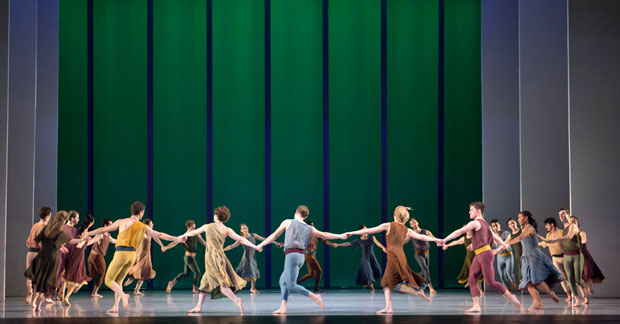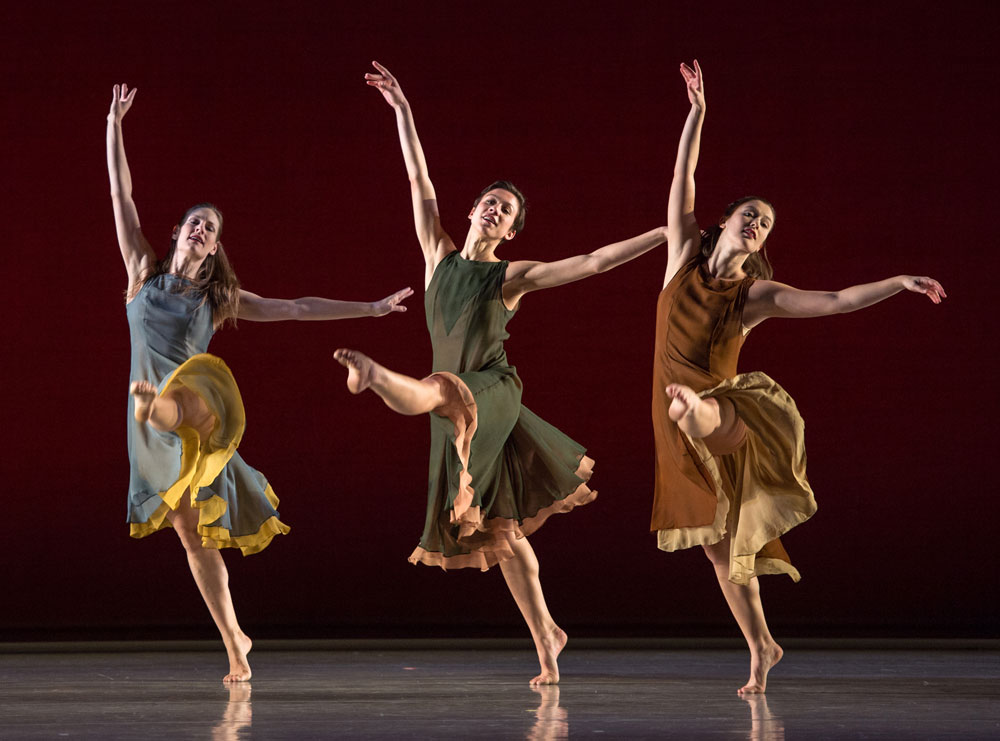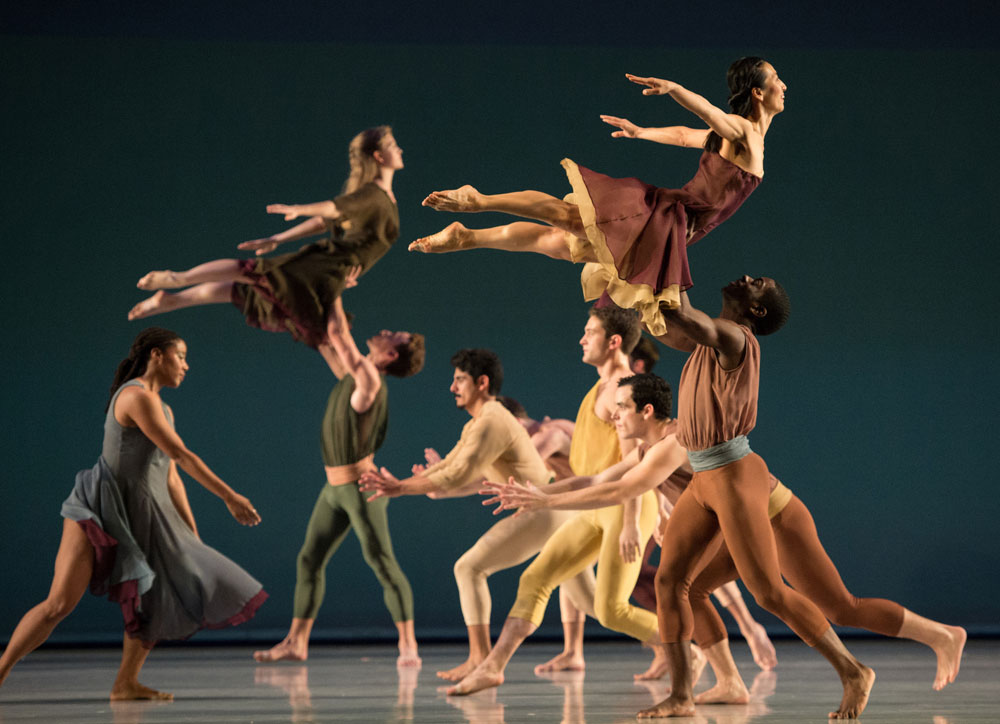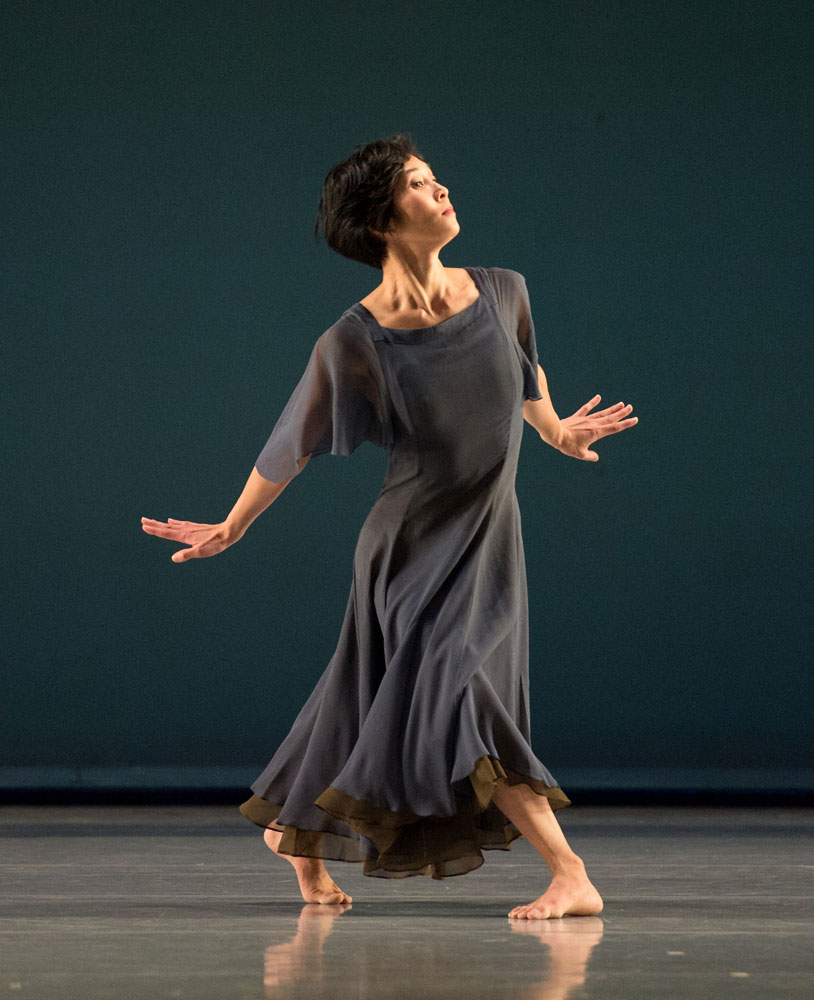
© Kevin Yatarola. (Click image for larger version)
Mark Morris Dance Group
L’Allegro, il Penseroso ed il Moderato
New York, David Koch Theater, Lincoln Center
21 November 2013
markmorrisdancegroup.org
davidhkochtheater.com
Built to Last
The months leading up to the creation of Mark Morris’s L’Allegro, il penseroso, ed il moderato, currently being performed at the Koch Theater as part of the “White Light Festival,” were tense. It was 1988 and Morris had just been hired by the general director of the Théâtre Royal de la Monnaie, Gérard Mortier, to replace Maurice Béjart as the theatre’s director of dance. Morris had brought his own company to Brussels, and though he hired more through local auditions, they looked nothing like Béjart’s sexy, long-limbed ballerinas. The Belgians weren’t terribly happy about the change and Morris had already gotten into trouble with the press more than once for saying outrageous things about himself, his dancers, and – gasp – Béjart. The stakes could not have been higher.
By some alchemic process, this pressurized situation produced what is still one of Morris’s most pellucid, generous works, a kind of torrent of warmth and straightforwardness, undergirded by an assured sense of craft and a deep understanding of the human condition. (Though not quite as profound his recent Socrates.) The choice of music, Handel’s pastoral ode on poems by Milton, is particularly inspired. Its text consists of poems on the subject of mirth and melancholy, freely adapted by the eighteenth-century librettist Charles Jennens, with an addendum on reason (“Il Penseroso”) by Jennens. Throughout the piece, the mood and focus shifts from darkness to light, from the joys of nature to the hubbub of urban life, from animal instinct to human folly, architecture to philosophy. In one of the dance’s most blissful passages, set to the poem “As Steals the Morn Upon the Night,” ribbons of dancers trace lines across the stage, pivoting at a corner, changing direction, walking toward us, then away, passing another garland of dancers on the diagonal. Throughout, the rhythm of their motion remains steady. We feel implicated in the dance. The calm zigzagging chains of bodies, joined at the elbow, become an endless line that extends into the past and future, embracing all humanity.

© Kevin Yatarola. (Click image for larger version)
This must be what people mean when they speak of timelessness. L’Allegro, with its painterly tableaux, classical references, and unselfconscious evocations of sex and death, feels both ancient – almost pagan – and perfectly of our time. I cannot imagine it will seem less so in fifty years. It also takes full advantage of theatre’s resources, giving equal weight to each element. The spacious, layered use of the stage – La Monnaie was the largest theatre Morris had ever worked in – imbues the steps with a sense of largesse and radiance. (Dancers echo each other across the stage, often separated by translucent scrims.) There is a lot of doubling. The orchestra pit is filled to bursting with orchestra players, chorus, and soloists, here under the baton of early music specialist Nicholas McGegan. The shifting palette of light, designed by James Ingalls, progresses from the dark of night to the glow of mid-day. In Adrianne Lobel’s designs, scrims and colored panels rise and fall, turning the stage into a cross between a jewel box, a rainbow, and a book of pastels. The jewel tones and textures of the costumes by Christine Van Loon – silky shifts for the women, colored tights and breezy tops for the men – seem to produce their own zephyrs. All this adds to the cumulative pleasure of the work.
But the dance’s greatest strength lies in its apparent simplicity, its intelligent construction and economy of means. Morris knows that things don’t have to look complicated to be satisfying. In L’Allegro, he keeps himself to a restrained number of steps, not unlike Paul Taylor in Esplanade: leaping, walking, jubilant running, rolling, classical-looking one-legged poses (for both men and women), flying lifts, lusty folk dances, and gentle spinning bourrée steps straight out of Isadora Duncan. As in Handel’s music, there’s a lot of repetition. The dance carefully shadows the music’s structure: canons, contrapuntal lines, and the conversation between soloist and ensemble. Groups subdivide into more groups, or mysteriously intermingle to become a giant round. Rhythmic footwork closely mimics the patter of the lyrics. And there is much word-painting: we see birds, trees, foxes, milkmaids, bubbling brooks, a hunt. As always with Morris, there is a sense of play; in what is often referred to as the “Stupid Men’s Dance,” the guys alternate slapping each other silly and prancing around hand in hand like courtiers.

© Kevin Yatarola. (Click image for larger version)
The element that changes over time, of course, is the casting. At the Koch Theater, McGegan led a spry, rhythmically lively rendition of the score. The tempi, in particular, seemed well suited to the choreography. Nothing felt rushed, nothing dragged. “As Steals the Morn,” a beguiling duet for tenor and soprano, looked and sounded as if it had been conceived by Handel to coexist with Morris’s lilting walking patterns. After each line of text, the singers turned their backs to their conductor to watch the dancers. Audience, singers, and dancers coexisted in a kind of suspended time. The chorus, Riverside Choral Society Chamber Singers, sang with a unified, joyful tone. The soloists, however, were a mixed bag. Dominique Labelle, one of two sopranos, sounded strained, especially in the upper registers; Douglas Williams (a baritone) was overtaxed by Handel’s coloratura. Most pleasing was Yulia Van Doren’s warm, mellifluous soprano and expressive diction. But overall, the text did not register as clearly as it should have, which is a shame.
Some people will remember the original cast, from Brussels. Several generations of dancers have come and gone since1988. Many who danced in the first cast I saw, in 2005, have also retired. Julie Worden, a natural, relaxed dancer with long, nymph-like legs, is gone, but tiny, explosive Lauren Grant is still there; so too, the expansive, appealing Michelle Yard, and delicately precise Maile Okamura.

© Kevin Yatarola. (Click image for larger version)
The current crop of male dancers is less varied than it has been in recent times, and seems dominated by graceful, mid-sized, Apollonian types with beautiful physiques, crystalline footwork, and gentle demeanors. Dallas McMurray, who looks like an overgrown boy, stands out for his slightly goofy musicality. The women are more distinct. Rita Donohue projects an earthy sweetness, Stacy Martorana an irrepressible energy – before she came to Mark Morris she was dancer-in-training for Merce Cunningham. Morris’s company may be less idiosyncratic and individualized than it was 1988, when he was still the age of some of his dancers but there’s no question, L’Allegro was built to last.

















You must be logged in to post a comment.